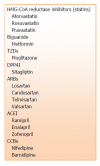Endothelial progenitor cells in cardiovascular diseases
- PMID: 25126384
- PMCID: PMC4131276
- DOI: 10.4252/wjsc.v6.i3.355
Endothelial progenitor cells in cardiovascular diseases
Abstract
Endothelial dysfunction has been associated with the development of atherosclerosis and cardiovascular diseases. Adult endothelial progenitor cells (EPCs) are derived from hematopoietic stem cells and are capable of forming new blood vessels through a process of vasculogenesis. There are studies which report correlations between circulating EPCs and cardiovascular risk factors. There are also studies on how pharmacotherapies may influence levels of circulating EPCs. In this review, we discuss the potential role of endothelial progenitor cells as both diagnostic and prognostic biomarkers. In addition, we look at the interaction between cardiovascular pharmacotherapies and endothelial progenitor cells. We also discuss how EPCs can be used directly and indirectly as a therapeutic agent. Finally, we evaluate the challenges facing EPC research and how these may be overcome.
Keywords: Cardiovascular diseases; Diabetes; Dyslipidemia; Endothelial progenitor cells; Hypertension; Stents; Therapy.
Figures



References
-
- Murray CJ, Lopez AD. Global mortality, disability, and the contribution of risk factors: Global Burden of Disease Study. Lancet. 1997;349:1436–1442. - PubMed
-
- Poh KK. Gene and cell therapy for chronic ischaemic heart disease. Expert Opin Biol Ther. 2007;7:5–15. - PubMed
-
- Dzau VJ, Gnecchi M, Pachori AS, Morello F, Melo LG. Therapeutic potential of endothelial progenitor cells in cardiovascular diseases. Hypertension. 2005;46:7–18. - PubMed
-
- Shantsila E, Watson T, Lip GY. Endothelial progenitor cells in cardiovascular disorders. J Am Coll Cardiol. 2007;49:741–752. - PubMed
-
- Asahara T, Murohara T, Sullivan A, Silver M, van der Zee R, Li T, Witzenbichler B, Schatteman G, Isner JM. Isolation of putative progenitor endothelial cells for angiogenesis. Science. 1997;275:964–967. - PubMed
Publication types
LinkOut - more resources
Full Text Sources
Other Literature Sources

